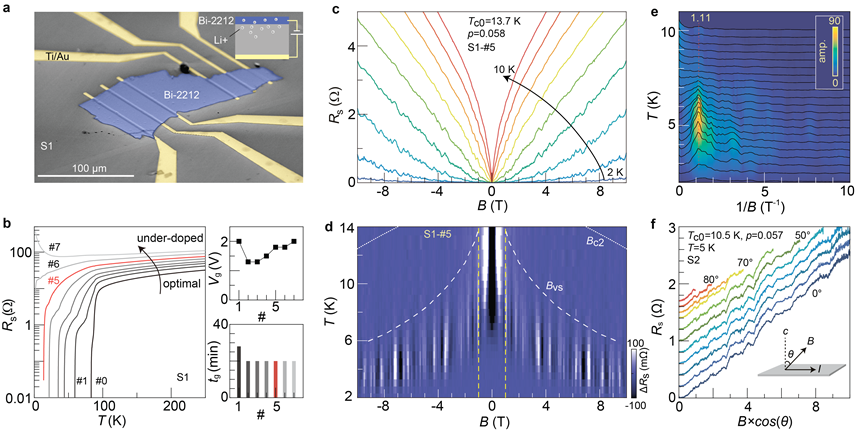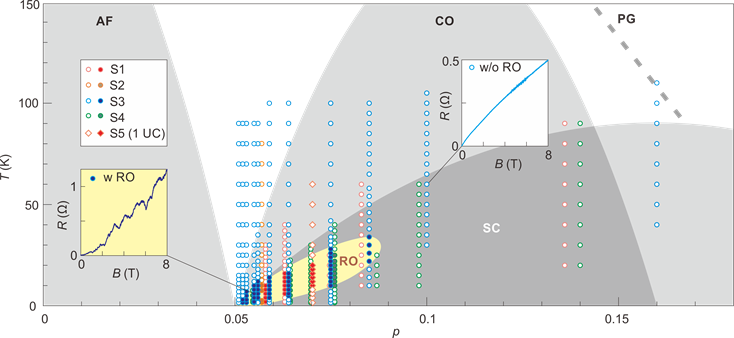Physicists from the High-temperature Superconductivity Group Discovered A Novel Type of Resistance Oscillations in Cuprates
2022/03/23
The mechanism of high-temperature superconductors remains an open question in condensed matter physics. In cuprates, superconductivity emerges from the Mott insulating phase with increasing doping. The critical regime in which superconductivity just arises, i.e. the lightly-doped regime, may therefore provide important insights into the mechanism of high-temperature superconductivity. However, this regime remains unexplored for a long time owning to technical difficulties in preparing high quality sample. Recently, a team led by Prof. Ding Zhang and Prof. Qi-Kun Xue managed to carry out a systematic transport study in the lightly doped regime. This breakthrough was reached thanks to the recent technical advances in sample modulations of the group. Interestingly, a novel type of magnetoresistance oscillations, which was reminiscent to the Little-Parks oscillations, was discovered. Their study, entitled "Little-Parks like oscillations in lightly doped cuprate superconductors", was published in Nature Communications on 14th March 2022.

Figure 1 a, Image of the sample. b, Temperature dependent resistance curves. c, Resistance oscillations observed in the lightly doped regime. d, Color plot of the background subtracted magnetoresistance oscillations. e, Fast Fourier transform (FFT) of the data. f, Angular dependence of the oscillations.
High-quality crystals in the lightly doped regime are extremely difficult to obtain by traditional methods. To overcome this difficulty, the group developed the solid ionic gating technique. In 2018, they successfully realized the continuous modulation of doping from the optimal to the lightly doped regime in Bi2Sr2CaCu2O8+x (M. Liao et al. Nano Lett. 18, 5660 (2018)). By using this technique, Menghan Liao, who was a core member of the team, carried out a systematic magneto-transport investigation of Bi2Sr2CaCu2O8+x in the lightly dope regime. To everyone’s surprise, periodic magnetoresistance oscillations were observed when the doping level was tuned to be lower than 0.1. The team further reproduced the results in multiple samples. They excluded origins such as quantum oscillations of normal states, mesoscopic oscillations, as well as plastic deformation of vortex lattices. Instead, the team pointed out that the oscillations were similar to the Little-Parks effect that occurs in periodic superconducting networks. However, the superconducting cuprate flake was not artificially patterned, suggesting that the periodic structures emerge spontaneously. The team further estimated that the oscillations correspond to a spatial period of 50 nm. They even managed to explain the temperature dependence of the oscillation amplitude in a quantitative manner. The extracted physical parameters, such as London penetration depth, are consistent with previous experiments. It reaffirms that there spontaneously emerges a periodic structure. The large period of 50 nm is much larger than that of the previously observed charge orders in cuprates. It indicates that there coexist different charge orders in lightly doped cuprates. In general, this work shows that novel phenomena can still be found in cuprate, even after 36 years since its debut.

Figure 2 Phase diagram in which the resistance oscillations occur. Each symbol represents the doping level and temperature at which the magnetoresistance was measured. The filled (empty) symbols indicate the resistance oscillations present (absent).
The experiment was carried out with the assistance of Dr. Yuying Zhu (Beijing Academy of Quantum Information Science) and PhD candidate Shuxu Hu (Tsinghua University). The single crystals were provided by Ruidan Zhong, John Schneeloch and Prof. Genda Gu of Brookhaven National Laboratory. This work was financially supported by the Ministry of Science and Technology (MOST) of the People’s Republic of China, the National Natural Science Foundation of China (NSFC), the State Key Laboratory of Low Dimensional Quantum Physics at Tsinghua University and the Beijing Advanced Innovation Center for Future Chips (ICFC).
 中文
中文 Email
Email QCloud
QCloud Log in
Log in
